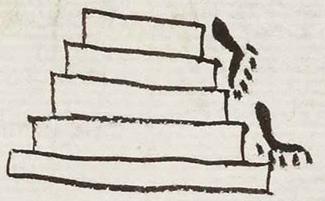Temoayan (Mdz27r)
This compound glyph for the place name Temoayan (perhaps "Customary Descending [Place]") consists of two elements, a pyramid/temple that provides a structure for one to descend (temo) or for all to descend (temoa). The descent is represented by two alternating black footprints heading down the steps. The -yan locative suffix is not shown visually. The pyramid is white with black outlines of steps that get smaller on all sides as it goes up. The result is a stack of rectangles.
Stephanie Wood
The locative suffix -yan is one that attaches to verbs and indicates customary action. So, this is a place where the descending occurs regularly. (Source: Frances Karttunen, "Critique of glyph catalogue in Berdan and Anawalt edition of Codex Mendoza," unpublished manuscript.)
Footprint glyphs have a wide range of translations. In this collection, so far, we can attest to yauh, xo, pano, -pan, paina, temo, nemi, quetza, otli, iyaquic hualiloti, huallauh, tepal, tetepotztoca, totoco, otlatoca, -tihui, and the vowel "o." Other research (Herrera et al, 2005, 64) points to additional terms, including: choloa, tlaloa, totoyoa, eco, aci, quiza, maxalihui, centlacxitl, and xocpalli.
Stephanie Wood
Stephanie Wood
c. 1541, or by 1553 at the latest
Stephanie Wood
Tēmoayān, Temoaya, nombres de lugares

temo, to descend, https://nahuatl.wired-humanities.org/content/temo
temoa, all descend, https://nahuatl.wired-humanities.org/content/temoa-0
"Donde ocurre el descenso" o "Donde el descenso tiene lugar"
Miguel León-Portilla, "Los nombres de lugar en náhuatl," Estudios de Cultura Náhuatl 15 (1982), 40, 42.
Codex Mendoza, folio 27 recto, https://digital.bodleian.ox.ac.uk/objects/2fea788e-2aa2-4f08-b6d9-648c00..., image 64 of 188.
The Bodleian Libraries, University of Oxford, hold the original manuscript, the MS. Arch. Selden. A. 1. This image is published here under the UK Creative Commons, “Attribution-NonCommercial-ShareAlike 3.0 License” (CC-BY-NC-SA 3.0).







